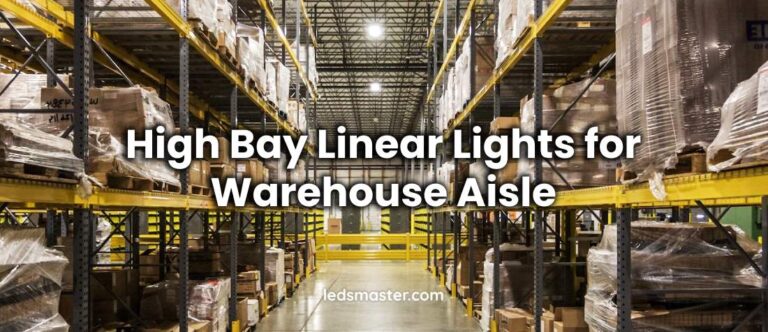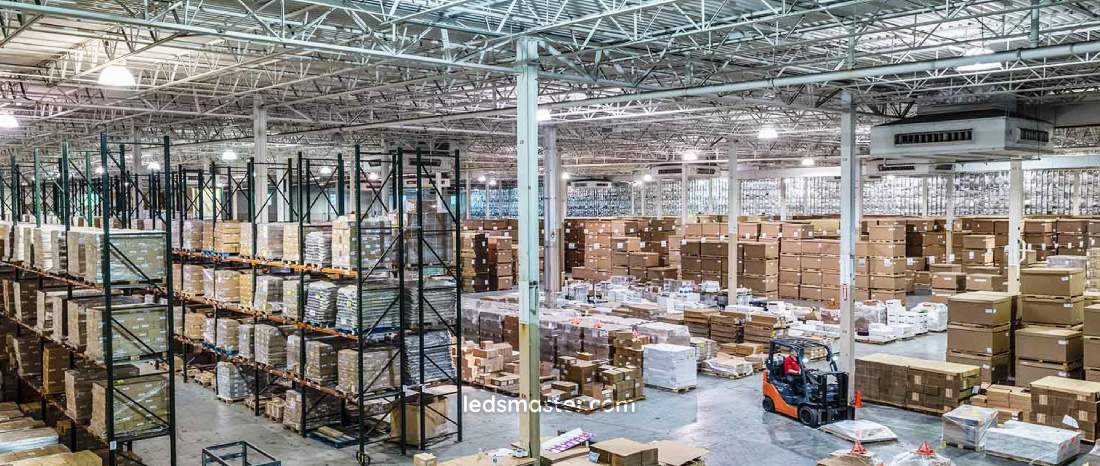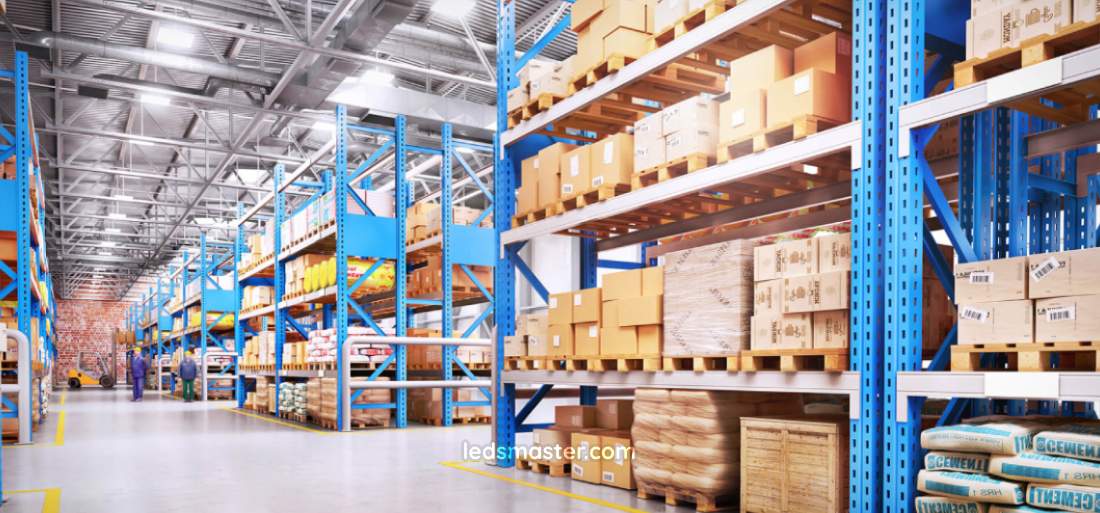
Imagine a warehouse where every task is clear and safe, thanks to smart lighting design. The right lighting transforms your space, enhancing productivity and safety. Discover how optimal lighting choices can revolutionize your warehouse operations and create a more efficient workspace.
Get your complimentary lighting design today
Adequate lighting within a warehouse boosts both workplace safety and logistical efficiency. This guide explores lighting design for various warehouse areas, including loading, distribution, packaging, and storage. It also examines the benefits and drawbacks of replacing traditional lighting fixtures—such as metal halide, mercury vapor, halogen, and high-pressure sodium (HPS) floodlights—with LED alternatives. Additionally, if energy savings are a priority, incorporating solar-powered panels can be a valuable consideration.
Table of Contents
ToggleIn a warehouse setting, achieving the right ground lux level is crucial for ensuring both safety and operational efficiency. Adequate illumination is necessary to prevent accidents and to facilitate smooth operations. For high-activity areas such as loading docks and unpacking zones, a brightness level of 200 to 300 lux is recommended. This level helps workers to clearly see and navigate their environment, minimizing the risk of accidents involving forklifts and other equipment. Conversely, storage areas, which generally require less intense lighting due to their less dynamic nature, should maintain a minimum of 100 lux. This standard ensures that while visibility is sufficient for routine tasks, it does not contribute to unnecessary energy consumption.

Lighting uniformity is a critical factor often overlooked in warehouse design. Inconsistent lighting, characterized by patches of varying brightness, can create discomfort and reduce productivity among workers. More significantly, uneven lighting can lead to industrial accidents as employees may struggle to see heavy-duty vehicles or uneven ground. To address this issue, the use of lighting simulation software like DIALux is highly beneficial. This software allows for precise estimation of ground lux levels across the warehouse, helping to ensure that lighting is evenly distributed. Proper planning and execution in this area will enhance safety and operational efficiency by providing a consistent and comfortable visual environment.
Selecting the correct type of light distribution is essential for optimizing warehouse lighting. Type I distribution, characterized by its oval and narrow illumination, is ideal for aisles. This type effectively utilizes symmetrical, longitudinal lighting, which minimizes the need for additional fixtures and reduces glare. On the other hand, Type II distribution, which provides asymmetric illumination, is more suitable for situations where fixtures are not centered within the aisle. This type ensures that light is distributed more effectively across the entire space, enhancing visibility and safety.
Effective lighting design within a warehouse must consider both the spacing between racks and the height of the ceiling. If luminaires are positioned directly above racks, their effectiveness can be severely diminished as the light may be blocked, casting significant shadows. To avoid this, a detailed examination of the storage unit’s floor plan is essential. By analyzing the layout, a lighting designer can develop a tailored lighting arrangement that ensures even illumination throughout the storage area. This approach helps in achieving optimal visibility and minimizing shadows, which is crucial for efficient operations and safety.
For various warehouse applications, including loading areas and logistics centers, different types of high bay lights are available. These include flood lights, light bars, light tubes, and solar lights. Each type of lighting solution has its unique advantages, and selecting the right one depends on the specific requirements of the area being illuminated. Flood lights, for instance, are ideal for providing broad, intense illumination, while light tubes and bars can offer more focused lighting. Solar lights present an energy-efficient option for reducing electricity costs while contributing to sustainability. Our team is dedicated to designing the most effective lighting solution tailored to your warehouse’s needs.
Modern warehouse lighting systems often come equipped with advanced control options such as DMX and DALI systems. These control systems offer user-friendly management of brightness levels, allowing for precise adjustments to suit varying conditions. Additionally, grouping luminaires to enable simultaneous on/off functionality enhances convenience and efficiency. Photosensors can also be integrated into the system to dynamically adjust brightness based on the ambient light levels within the warehouse. This adaptability ensures that lighting conditions remain optimal throughout the day, contributing to both energy savings and improved working conditions.

LED lighting offers significant improvements in energy efficiency compared to traditional lighting options. Our LED lights boast a high luminous efficacy of 130 lumens per watt, meaning that each watt of power consumed generates 130 units of brightness. In contrast, metal halide lights typically provide around 75 to 90 lumens per watt, while halogen bulbs are far less efficient, delivering only 15 to 20 lumens per watt. This substantial difference in efficiency translates to considerable energy savings when switching from conventional lighting to LEDs. By retrofitting warehouse ceiling lights with LEDs, you can achieve up to 75% reduction in energy consumption. This not only lowers electricity costs but also contributes to environmental sustainability by reducing your carbon footprint.
One of the major advantages of LED warehouse lighting is its flexibility. LEDs come in a diverse range of specifications, including various power levels, beam angles, color rendering indexes (CRI), sizes, and weights. This versatility allows for customization to meet the specific needs of any warehouse environment. Our LED offerings include flood lights with power ratings ranging from 400W to 10,000W, and we provide options for customized installation brackets and accessories. This wide array of choices ensures that you can find the ideal lighting solution for your warehouse’s unique requirements. Our engineers are available to discuss the many possibilities and help you design a tailored lighting system that maximizes efficiency and functionality.
In addition to their energy efficiency, LED lights are known for their durability. Unlike metal halide high bay lights, which typically require replacement every 1 to 2 years due to rapid brightness degradation, LEDs offer a much longer lifespan. Our LED lights have a life expectancy of approximately 80,000 hours, translating to around 18 years if used for 12 hours per day. Although the initial installation cost of LEDs may be comparable to or even higher than that of traditional lamps, the long-term savings in maintenance and replacement costs make LEDs a cost-effective choice. Whether you are outfitting a new warehouse or retrofitting an existing space, LEDs provide a reliable and long-lasting lighting solution.
Flickering lights can cause eye strain and discomfort, a common issue with fluorescent tubes. While these lights are generally cheaper, they are prone to flickering, which can be subtle but bothersome over time. In contrast, LED lighting fixtures are designed to be flicker-free. Our laboratory tests show that the amplitude of flicker in our LEDs is less than 0.3% of the average lumen output, ensuring that there is no noticeable strobing even when observed under a 5000 fps slow-motion camera. This feature makes LEDs a more comfortable choice for warehouse environments, reducing visual fatigue and improving overall working conditions.
LED lighting is versatile enough to operate effectively in both cold storage and high-temperature environments. Our LED fixtures are designed to withstand extreme temperatures, with models that can function at temperatures as low as -45ºC for cold storage applications and up to 100ºC for high-temperature industrial processes. The advanced heat dissipation systems in our LEDs help maintain lower junction temperatures, ensuring consistent performance and longevity even in challenging conditions. Our engineers can help you select the best lighting solution tailored to your specific temperature requirements.
For areas prone to exposure to the elements, such as loading docks, waterproof lighting is essential. Our LED lights feature an IP66 waterproof rating, meaning they are fully protected against dust and can withstand powerful jets of water from any direction. This makes them a reliable choice for environments where heavy rain or other moisture conditions are a concern. Compared to HID lamps and fluorescent tubes, LED lights offer superior resilience and durability in wet conditions.
The operational cost of warehouse lighting can significantly impact your overall budget. For a 1,000 square meter warehouse with a required illumination level of 200 lux, approximately 2,000W of LED flood lights would be needed. The running cost for these LEDs would be calculated as follows: 2,000W x 24 hours x $0.12 / 1,000 = $5.76 per day, translating to about $172.80 per month. In comparison, halogen lights would require 20,000W, leading to ten times higher electricity costs. By replacing traditional HID or halogen lights with LEDs, you can achieve substantial savings.
Proper ground lux levels, uniform illumination, and strategic fixture placement are key to creating a well-lit environment. LED lighting excels with its superior energy efficiency, durability, and adaptability to various conditions. Although there is a higher initial cost and potential compatibility issues, the long-term benefits, such as reduced energy consumption and maintenance, make LEDs a smart choice. Investing in quality LED solutions enhances safety, lowers costs, and improves overall warehouse operations.